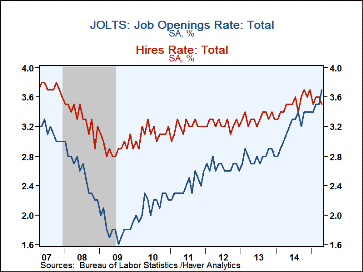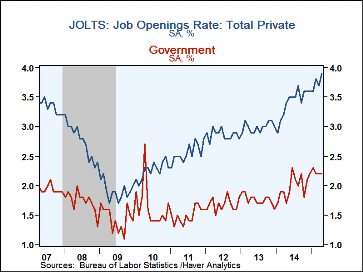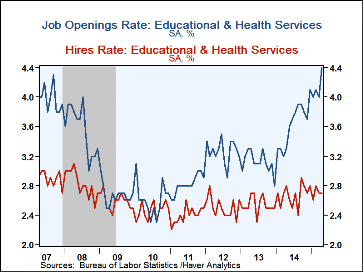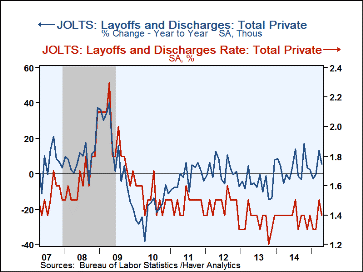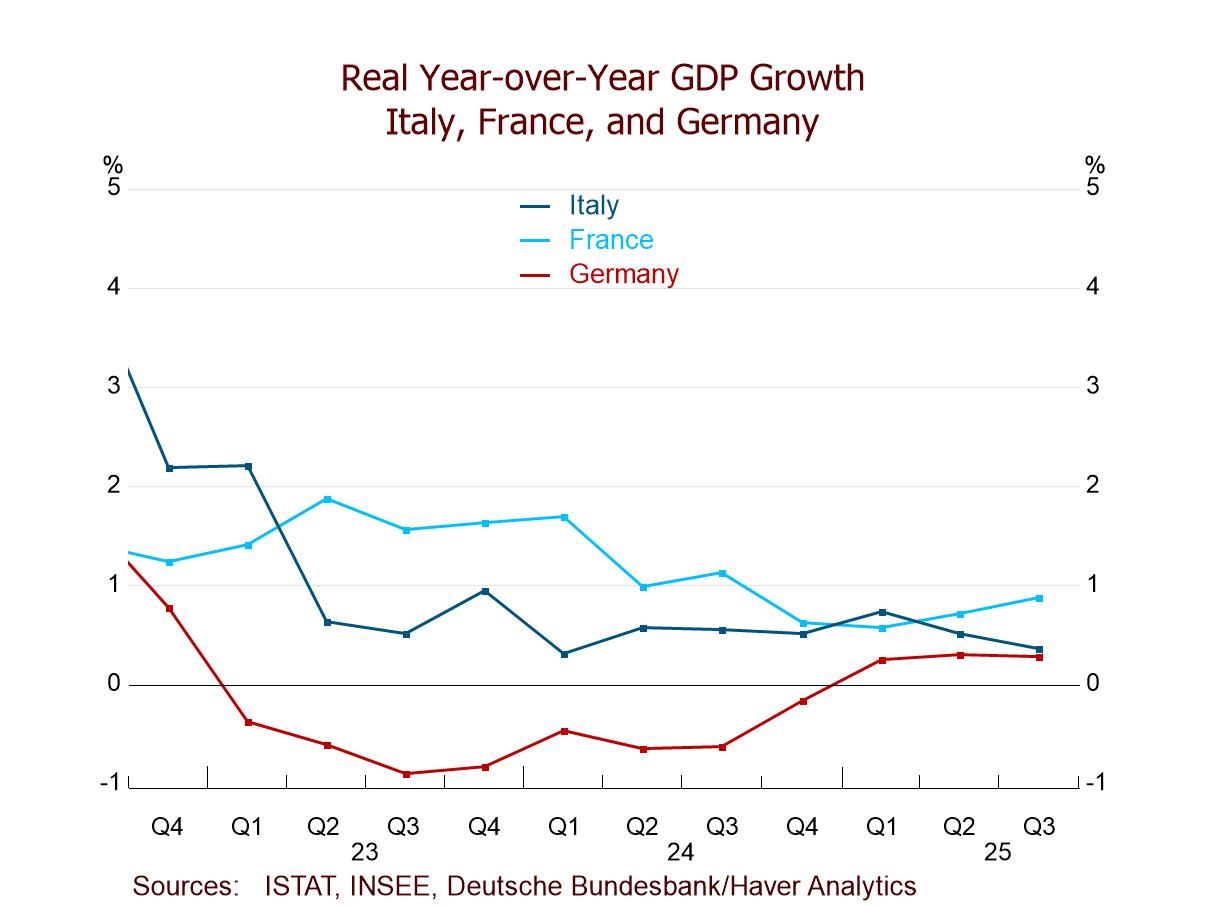 Global| Jun 09 2015
Global| Jun 09 2015U.S. JOLTS: Job Openings Rate Strengthens but Hiring Fails to Keep Pace
by:Tom Moeller
|in:Economy in Brief
Summary
The emerging labor shortage was evidenced by the job openings rate during April. It gained m/m to 3.7%, up from the recession low of 1.6%. It was just below the series' high of 3.8% early in 2001. The job openings rate is the number [...]
The emerging labor shortage was evidenced by the job openings rate during April. It gained m/m to 3.7%, up from the recession low of 1.6%. It was just below the series' high of 3.8% early in 2001. The job openings rate is the number of job openings on the last business day of the month as a percent of total employment plus job openings. Failing to keep pace, however, was the hires rate. It fell to 3.5% and has been trending sideways for the last year. The hires rate is the number of hires during the month divided by employment. The Bureau of Labor Statistics reports these figures in its Job Openings & Labor Turnover Survey (JOLTS).
The actual number of job openings surged 21.7% y/y to 5.376 million versus 5.109 million in March, revised from 4.994 million. Hiring was less strong as it posted a 4.5% y/y increase to 5.007 million. That was down from 5.088 million in March, revised from 5.067 million.
The private-sector job openings rate jumped to 3.9% and was improved from the recession low of 1.7%. The rate in professional & business services rose to a recovery high of 5.1% while the rate in leisure & hospitality held at 4.7%, nearly the cycle high. In health care & social services, the rate jumped m/m to an eight-year high of 4.7% and in trade, transportation & utilities, it surged to a record high of 3.5%. The rate in the factory sector held steady for the third month at an elevated 2.6% but the construction sector's rate fell to 2.3%. The job openings rate in the government sector remained at 2.2%, higher than the 2009 low of 1.1%.
The private sector hires rate slipped to 3.9% and has been trending sideways for a year. Amongst leisure & hospitality firms, the rate continued its sideways trend with a slip to 6.1%. The rate in professional & business services did the same with a drop to 5.3%. The construction sector rate gained marginally to 5.1% but remained down from its December high of 7.0%. In retail trade it fell to 4.6%, nearly its lowest since early last year. The hiring rate in education & health services continued moving sideways at 2.7% and in the factory sector, it held at 2.1%. In the government sector, the hiring rate held at 1.5%.
The number of hires declined 1.6% m/m (+4.5% y/y). Private sector hires fell 1.9% (+3.8% y/y). Trade, transportation & utilities jobs declined 1.1% y/y. That was offset by a 7.2% rise in construction employment and a 7.8% increase in leisure & hospitality hiring. Health care & social services employment improved 0.6% y/y while professional & business services jobs increased 4.9% y/y. Factory sector jobs improved 2.0% y/y while government sector hiring jumped 16.1% y/y.
The job separations rate slipped from its recovery high to 3.5% but the actual number of separations increased 7.9% y/y. Separations include quits, layoffs, discharges, and other separations as well as retirements. The private sector separations rate fell to 3.8% while the government sector's rate held at the five-year high of 1.5% for the fourth straight month. The layoff & discharge rate held at 1.3%, the highest level since July. The private sector layoff rate slipped to 1.4% but the government's rate held at 0.5% for the sixth consecutive month.
The JOLTS survey dates to December 2000 and the figures are available in Haver's USECON database.
| JOLTS (Job Openings & Labor Turnover Survey, SA) | Apr | Mar | Feb | Apr '14 | 2014 | 2013 | 2012 |
|---|---|---|---|---|---|---|---|
| Job Openings, Total | |||||||
| Rate (%) | 3.7 | 3.5 | 3.5 | 3.1 | 3.4 | 2.8 | 2.6 |
| Total (000s) | 5,376 | 5,109 | 5,144 | 21.7% | 22.6% | 9.3% | 3.2% |
| Hires, Total | |||||||
| Rate (%) | 3.5 | 3.6 | 3.6 | 3.5 | 42.2 | 39.8 | 38.8 |
| Total (000s) | 5,007 | 5,088 | 5,011 | 4.5% | 8.4% | 3.4% | 4.2% |
| Layoffs & Discharges, Total | |||||||
| Rate (%) | 1.3 | 1.3 | 1.2 | 1.2 | 14.5 | 14.6 | 15.5 |
| Total (000s) | 1,817 | 1,894 | 1,688 | 6.7% | 2.4% | -4.9% | 1.1% |
Tom Moeller
AuthorMore in Author Profile »Prior to joining Haver Analytics in 2000, Mr. Moeller worked as the Economist at Chancellor Capital Management from 1985 to 1999. There, he developed comprehensive economic forecasts and interpreted economic data for equity and fixed income portfolio managers. Also at Chancellor, Mr. Moeller worked as an equity analyst and was responsible for researching and rating companies in the economically sensitive automobile and housing industries for investment in Chancellor’s equity portfolio. Prior to joining Chancellor, Mr. Moeller was an Economist at Citibank from 1979 to 1984. He also analyzed pricing behavior in the metals industry for the Council on Wage and Price Stability in Washington, D.C. In 1999, Mr. Moeller received the award for most accurate forecast from the Forecasters' Club of New York. From 1990 to 1992 he was President of the New York Association for Business Economists. Mr. Moeller earned an M.B.A. in Finance from Fordham University, where he graduated in 1987. He holds a Bachelor of Arts in Economics from George Washington University.


